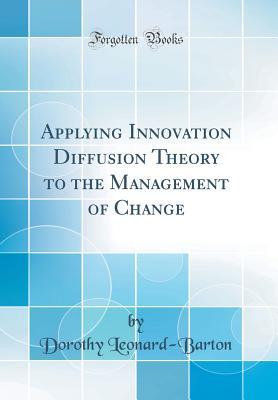Read Online Applying Innovation Diffusion Theory to the Management of Change (Classic Reprint) - Dorothy Leonard-Barton | ePub
Related searches:
Using diffusion of innovation theory to understand the factors
Applying Innovation Diffusion Theory to the Management of Change (Classic Reprint)
An application of the Diffusion of Innovations theory to the
The Diffusion of Innovation – Strategies for Adoption of Products
How The Diffusion of Innovation Can Inform Product Marketing
Applying innovation diffusion theory to the management of change
Application of innovation diffusion theory to the E-learning
Application of Innovation Diffusion Theory to the E-learning
CHIPS Articles: The Diffusion of Innovation - DON CIO
Planned Behavior Change: An Overview of the Diffusion of Innovations
The Diffusion of Innovation - Unite For Sight
APPLYING THE DIFFUSION OF INNOVATIONS MODEL TO ACTIVE
The application of Technology Acceptance and Diffusion of
Diffusion of innovation theory for clinical change The Medical
Applying the Diffusion of Innovation Theory to Characterize
Few social science theories have a history of conceptual and empirical study as long as does the diffusion of innovations.
Complexity is used to explain the degree to which an innovation is difficult to use, understand, or apply.
Diffusion of innovations seeks to explain how innovations are taken up in a population.
The study showed that diffusion of innovations can be used to research blended language learning.
The diffusion of innovation theory explains the rate at which consumers will adopt a new product or service.
Applying diffusion of innovation theory to intervention development few social science theories have a history of conceptual and empirical study as long as does the diffusion of innovations.
The standard variable for innovation diffusion theory (technical compatibility, simplicity, relative advantage, and intentions) was used in the current research model. The variables derived from other related studies on the extension of the idt (trialability and observability) were also included to have a deeper understanding of the phenomenon.
Dec 11, 2018 the theory is built around the notion that consumers respond to innovation trends differently, and are thus placed in different consumer categories.
Mar 28, 2018 diffusion of innovation theory suggests that people who adopt an innovation early on in the diffusion model will possess different characteristics.
Applyinginnovationdiffusiontheoryto themanagementofchange by dorothyleonard-barton sloanschoolofmanagement introduction managementtodayusuallyinvolves,atsomelevel.
In 1962 everett rogers introduced his innovation diffusion theory (idt) which has been referenced often in case analysis since. It provides a foundation for understanding innovation adoption and the factors that influence an individual’s choices about an innovation.
This article summarizes rogers' diffusion of innovations theory. My purpose the ability to understand and apply complex technical knowledge is also needed�.
The diffusion of innovations theory describes the pattern and speed at which new ideas, practices, or products spread through a population.
In this module three key innovation theories are included and by the end a more the potential impact of new technology – in general, as well as for a specific application.
Applying theory of diffusion of innovations to evaluate technology acceptance and sustainability.
Applying the communication theory of diffusion of innovations to economic sciences: a response to the ‘ using gossips to spread information ’ experiments conducted by the 2019 nobel laureates.
Using roger’s (rogers, 2003) diffusion of innovation theory made it possible to analyze the implementing processes for new educational policies as multi-faceted and susceptible to influences from stakeholders’ societal value systems.
Diffusion of innovations are applicable to the complex context of health care, for both explanatory and interventionist purposes.
Applying innovation diffusion theory to the management of change book.
Early theorizing from the beginning of the 20th century was gradually displaced by post hoc empirical research that described and explained diffusion processes. By the 1950s, diffusion researchers had begun to apply the collective knowledge learned about naturalistic diffusion in tests of process interventions to affect the spread of innovations.
Jun 19, 2018 the diffusion of innovation is the process by which new products are adopted (or not) by their intended audiences.
This publication is designed to provide an overview of how the principles of diffusion can be applied to facilitate planned behavior change in extension clientele.
The robustness of this theory derives from the many disciplines and fields of study in which diffusion has been studied, from the international richness of these studies,.
The diffusion of innovation theory explains the rate at which consumers will adopt a new product or service. Therefore, the theory helps marketers understand how trends occur, and helps companies in assessing the likelihood of success or failure of their new introduction.
Jan 16, 2018 application of diffusion of innovation theory to educational accountability: the case of efl education in japan.
One of the leading theories regarding the acceptance recognition is theory on diffusion of innovations by rogers.
Diffusion of innovations (doi) is a complex and intricate theory applied in a variety of contexts. This review investigates the five key attributes of innovation in doi (relative advantage, compatibility, complexity, trialability, and observability), as well as the stages of diffusion within innovators (early adopters, early.
The research and practice paradigm known as the diffusion of innovations offers a ready set of concepts and approaches that can be used to explain receptivity to health care policies and practices.

Post Your Comments: